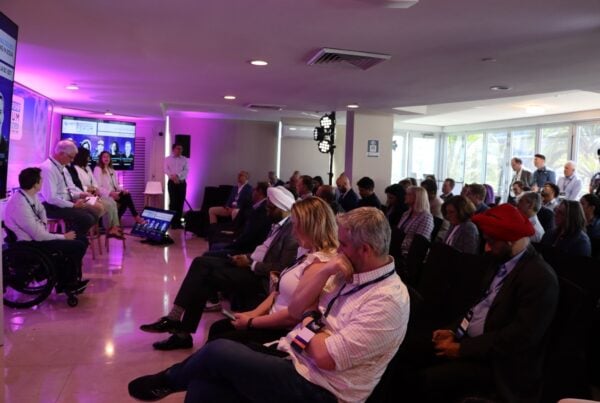MEF Advisor Doug Makishima discusses the commercialization of telco edge cloud and network API solutions ahead of an upcoming session at the MEF Global Forum, in Barcelona where he will present a panel of experts that will explore the importance of NaaS, MEC and APIs for the future of the interoperable mobile edge.
Interoperable Mobile Edge
5G is not just another “+1G” with even faster speeds (higher bandwidth) and reduced lag (lower latency), it marks a major shift in the journey from telco to tech-co for mobile network operators (MNOs).
5G offers an opportunity for MNOs to expose key network functions and controls via APIs and offer cloud edge computing services to app developers and enterprises using new industry standards. This new interoperable mobile edge enables advanced functionality, efficiency and security, while creating new monetization opportunities for operators and enterprises.
NaaS
Mobile operators are transforming their networks into open, standardized Network-as-a-Service (NaaS) platforms, enabling new applications and further accelerating digital transformation. Broadly speaking, NaaS means MNOs are exposing network services externally to enterprises and app developers to enable new services, and to also improve user experience and security for existing applications, all while creating new revenue potential for MNOs. And this isn’t just talk — MNOs are deploying 5G NaaS services commercially now.
The two initial NaaS focus areas for the program are: 1) cloud edge computing and 2) network services APIs. With cloud edge computing, also known as Multi-Access Edge Computing (MEC), enterprises can now “cloudify” applications that require low latency, data privacy, or extended security by shifting workload from on-prem servers or public cloud to telco MEC. The telco NaaS APIs enable exciting new applications that benefit from direct access to MNO network resources and functions such as Quality of Demand, Device Location, Number Verification and SIM Swap, as well as numerous marketing and business-related services. Taken to the extreme, NaaS enables operators to offer entire private 5G networks using “network slicing,” giving significantly more autonomy and control to enterprises.
Telco APIs
According to GMSA, “Open Gateway is a GSMA-led telco industry initiative that transforms telecommunications networks into standardized platforms exposed to developers, based on a framework of APIs designed to provide digital services like Device Status, Device Location, Number Verification, and Quality on Demand.
The initiative enables developers to break into new markets while customers benefit from new services and functionality.” GSMA has partnered with the Linux Foundation CAMARA project to standardize and implement the Open Gateway APIs. CAMARA is an open source project within Linux Foundation to define, develop and test the APIs. [add ETSI MEC, 5GFF overviews?]
Commercialization and rollouts of these NaaS APIs are already happening around the globe. Bridge Alliance, Asia’s largest mobile operator alliance that counts over 1 billion subscribers collectively, is working with its member operators to deploy Telco edge compute and NaaS API capabilities. “Telco APIs will be a game-changer for businesses looking to innovate and improve customer experiences. It will be a key to unlocking new opportunities and drive growth in the digital age,” says Ken Wee, SVP Partnership and New Business, Bridge Alliance.
Broadly speaking, NaaS means MNOs are exposing network services externally to enterprises and app developers to enable new services, and to also improve user experience and security for existing applications, all while creating new revenue potential for MNOs. And this isn’t just talk — MNOs are deploying 5G NaaS services commercially now.“
Orange, a leading MNO group that services Europe, Middle East and Africa, is pushing forward its Telco API initiatives as well. “Orange is actively collaborating with leading telecom operators to provide innovative services that go beyond basic connectivity. Orange has already made several Telco APIs in CAMARA format accessible to developers, embracing a new open ecosystem,” according to Sylvain Morel, Network API Governance at Orange. In another example, in partnership with Infobip, three Brazilian mobile operators Claro, TIM and Vivo have announced the launch of three network APIs focused on improving digital security. Deutsche Telekom and Verizon have both announced collaborations with Vonage for deployment of NaaS APIs.
NaaS APIs are not just about exposing technical network functions. They can also allow operators to unlock valuable business logic and subscriber data that can power new applications via APIs for ordering, inventory, resource availability, monetization (charging and billing), and customer insights — APIs such as those developed by the TM Forum through their ODA and Open API projects.
TM Forum is also in support of and in alignment with the GSMA Open Gateway framework, so as to avoid duplication and fragmentation: “The industry needs Open Gateway working with the TM Forum’s widely adopted Open APIs and Open Digital Architecture (ODA), as well as a few other elements to successfully monetize Network-as-a-Service and related network capabilities,” says George Glass, Chief Technology Officer, TM Forum.
Standards are important to provide the interoperability that developers need to “write once and run everywhere” to rapidly deploy new apps and services in any region and on any operator network, just like they can with today’s leading cloud hyperscalers. “Industry Standard APIs are fundamental to API-led connectivity design principles.
This enables ecosystem stakeholders to unlock data from systems, compose the data into processes and actionable insights, ultimately delivering a personalized experience to the customer,” says Abhi Sur, Senior Director, Salesforce. Salesforce hit a high note last fall as one of the leading vendors in an award-winning collaborative TM Forum “Catalyst” project for an operator NaaS/Edge marketplace that used both CAMARA and TM Forum APIs.
Mobile Cloud Edge Computing
MEC creates exciting new monetization opportunities for mobile operators and enterprises. Extending the cloud to the Telco edge has many benefits and enables many new applications and use cases.
There are several deployment options for MEC. Some MNOs elect to build their own MEC edge cloud on their infrastructure or use a hybrid cloud type deployment that combines a homegrown edge with hyperscaler cloud. One solution provider that enables such deployments is Red Hat. “Edge computing has given service providers an opportunity to modernize their networks and create new and exciting revenue streams by acting as an innovation driver for 5G networks. From advanced connectivity and private wireless for manufacturing, to 5G in software-defined vehicles, to multi-access edge computing, Red Hat is committed to extending transformation from the hybrid cloud to the edge and we’re excited to see what comes next,” says Hanen Garcia, global telco solutions manager, Red Hat.
Here’s an example of a collaborative trial completed by Summit Tech and Red Hat showing how operators can deploy cost-effective edge solutions using Red Hat OpenShift, an open hybrid cloud platform designed to support workloads across the most remote locations – from on-premises data centers to the public cloud to the remote edge. In another example Summit Tech and Bridge Alliance, SingTel and AIS Thailand collaborated on a GSMA Foundry multi-MNO edge trial, showing MEC federation for cross-carrier interoperability working across countries.
Some MNOs partner directly with hyperscalers, utilizing platforms such as AWS’ Wavelength solution to realize their MEC offerings. “Wavelength brings AWS services to the telco edge, allowing our customers to build next-generation applications that need to be deployed closer to the end-users. Combining AWS Wavelength with Telco’s Network API would allow customers to leverage differentiated network experience to innovate and bring to life new use cases in areas like AR/VR, Gaming, M&E, Finance,” says Mohit Gupta, Head of Product at Amazon Web Services (AWS), Edge Compute.
From Telco to Tech-co
NaaS is a transformative opportunity for MNOs. It has the potential to simultaneously provide more value to enterprises and subscribers, and boost MNOs profitability — by leveraging existing network resources via telco APIs, and by adding new value through MEC offerings. MNOs can once again be “service providers” rather than relegated to “data pipes.”
“Considering the AI and Cloud boom we are witnessing, compute resource has become the fourth pillar of 21st century infrastructure, after water, power and radio waves. We have reached the point where the craziest predictions from only a few years ago are now a reality, with silicon vendors shipping zettaflops of compute power each month. The world’s telecoms failed to fully capitalize on the 3G, 4G and a good portion of 5G waves, whereas the disrupting companies achieved valuations in trillions. With the global trends indicating that telcos want to become tech-cos, we see 5G+, Edge Compute and NaaS as a significant opportunity for telecoms to transform by bringing edge compute and their valuable network resources to billions of users,” says Theo Valich, CEO, Ecoblox
Stay tuned for much more as we spin up a new MEF program on telco innovation at the edge, and please come learn more about the state of innovation at the telco edge at the MEF Global Forum. And in the meantime, check out these previous MEF panels and webinars on this important topic: MEF Edge Webinar, MEF Global Forum ’23, and MEF Canada Leadership forum.
MEF Global Forum @MWC24 Panel Detail:
Telco Innovation at the Edge: NaaS/MEC/APIs
Feb 25 (Sunday) 14:45 to 15:30
Mobile operators are transforming their networks into open, standardized Network-as-a-Service (NaaS) platforms, enabling new applications and further accelerating digital transformation. Exposing network services externally to enterprises and app developers enables new services and also improves user experience and security for existing applications. With MEC (Multi-Access Edge Computing), enterprises can now cloudify applications that require low latency, data privacy, or extended security. NaaS APIs such as Quality of Demand, Device Location, Number Verification and SIM Swap, as well as those for marketing and business related services, enable exciting new applications that benefit from having direct access to network resources. Taken to the extreme, Operators can even offer entire private 5G networks using “network slicing,” giving significantly more autonomy and control to enterprises.
Moderator:
- Doug Makishima, MEF Advisor
Panelists:
- AWS: Mohit Gupta, Head of Product at Amazon Web Services (AWS), Edge Compute
- Bridge Alliance: Ken Wee, SVP Partnership and New Business
- Ecoblox: Theo Valich, CEO
- Orange: Sylvain Morel, Network API Governance
- Red Hat: Hanen Garcia, Global Telco Solutions Manager
- Salesforce: Abhi Sur, Senior Director – Product Management, Communications Industry






